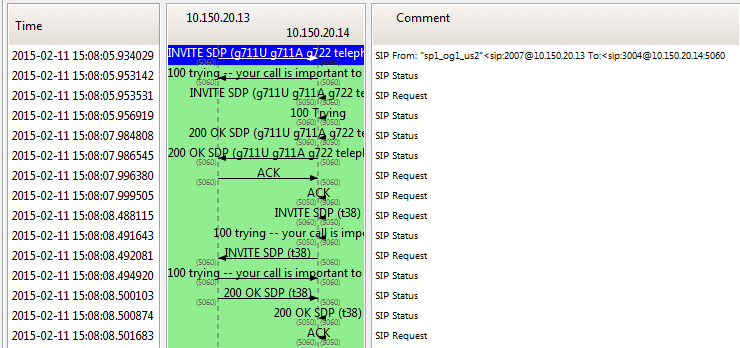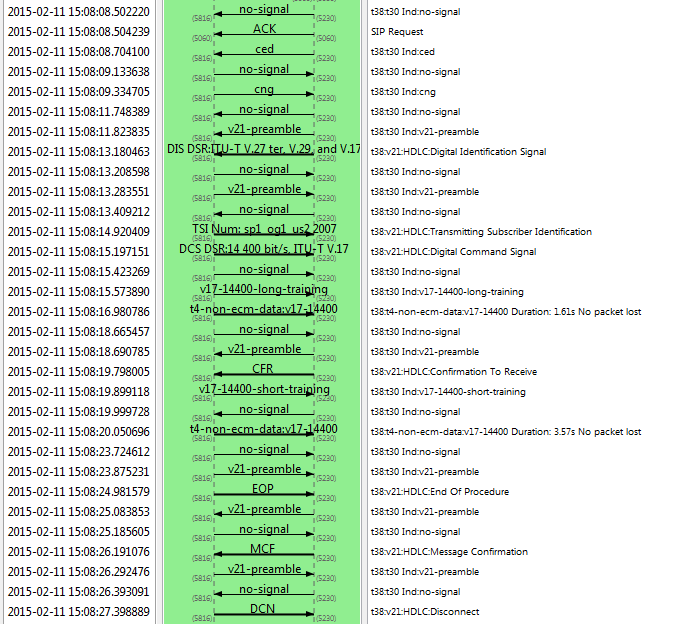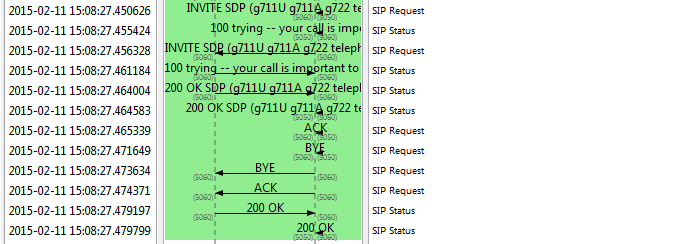...
- Verify the settings: the DID must be assigned to the correct extension, the fax must be enabled on the extension, you need to have enough disk space for faxes, etc.
If you've got all that covered, take a tcpdump capture of the fax. For fax transmission over t38, VoipNow uses udp ports 4000-5999 as defined in /etc/asterisk/udptl.conf:
Code Block udptlstart=4000 udptlend=5999
The other party may use different ports. So, the best way to capture a fax is to use a tcpdump command with a udp filter.
Code Block tcpdump -nni any -s 0 udp -w /usr/local/voipnow/admin/htdocs/fax.pcap
Note The correct sequence is: 1) start the capture; 2) send the fax; 3) wait for it to work or fail; 4) stop the capture.
Once the capture is done, you can download it with from the VoipNow server where it has been taken.
Code Block https://<VoipNow_IP>/fax.pcap
Open the capture using Wireshark. Go to Telephony >> Voip Calls and you will see a list of all the calls in the capture. You can identify the fax by the phone numbers used for sending / receiving the fax message. In our case, it was a fax from 2007 to 3004.
Select the fax and click Flow. In our example, we have a fax answered by VoipNow, so we only have one leg of this call: between the caller and the VoipNow server. If 3004 had been assigned to a fax machine, we would have had a second leg: from 2007 to the extension assigned to 3004. In such cases, select both legs of the call and then click Flow.
You will see a graph showing the SIP and t38 negotiation between the two parties, the sender (10.150.20.13) and the receiver (10.150.20.14).
...
- First the call is established over SIP, as a regular voice call. Then VoipNow generates a re-INVITE for t38 and the caller accepts it.
- If the operation is successful, the negotiation over t38 begins. If the operation fails, the fax either won't be sent, or it will be sent over an audio stream.
At this point, you should check the following:
- If the first INVITE is rejected by the VoipNow server, ensure that the caller sends the fax to the correct DID; check if 10.150.20.13 is in the accept list of the channel where 3004 is placed. If the call fails here, then this is not a fax-related issue, because regular calls would not work either.
If the t38 re-INVITE is rejected with an "Unsupported media" message, then the sender may not support t38. Make sure t38 is enabled on their side.
Note If our example would have been about an outgoing fax, then the first INVITE would have been sent by VoipNow. If you don't see it in the capture, you might be having configuration issues like bad outgoing routing rules, channel costs, and so on. An Asterisk log will help you identify the exact issue.
- If things so far went OK, this is when the t38 negotiation starts:
| Note |
|---|
| It's not necessary for the t38 negociation to happen between the same IPs as the SIP signalling. The two parties can establish this negotiation between different IPs. These IP addresses are mentioned in the "Connection Information" header in the SDP from the t38 INVITE/200OK. |
...
- The receiver (VoipNow) sends a "ced" (Fax answering tone) message
- The sender sends a "cng" (Origination fax calling tone) message.
- The handshake starts with the receiver sending a "DIS" (Digital Identification Signal) message stating its terminating capabilities.
- The sender responds with a "DCS" (Digital Command Signal) message, which indicates the transmission mode that will be used by the sender.
- The receiver sends a "CFR" (Confirmation To Receive). This indicates that it's ready to receive the fax.
- The sender will now begin to send the fax.
- If there are several pages in the fax message, a "MPS" (multipage signal) message will be sent after each page.
- The receiver sends a "MCF" (Message Confirmation) after receiving each page.
- Once all pages are sent, an "EOP" (End Of Procedure) message is sent.
- The receiver sends a "MCF" (Message Confirmation) indicating that the fax was received.The caller will disconnect the call with a "DCN" (Disconnect) message.
...
If the previous fax was successfully sent, the call returns to a regular audio call and is hung up.
| Note |
|---|
Make sure the call ends properly with a BYE, followed by a 200 OK message. Otherwise, you might get stuck calls in Kamailio. |
...
| Content by Label | ||||||||||||||||||
|---|---|---|---|---|---|---|---|---|---|---|---|---|---|---|---|---|---|---|
|
...
| hidden | true |
|---|
|
...
Except where otherwise noted, content in this space is licensed under a Creative Commons Attribution 4.0 International.




